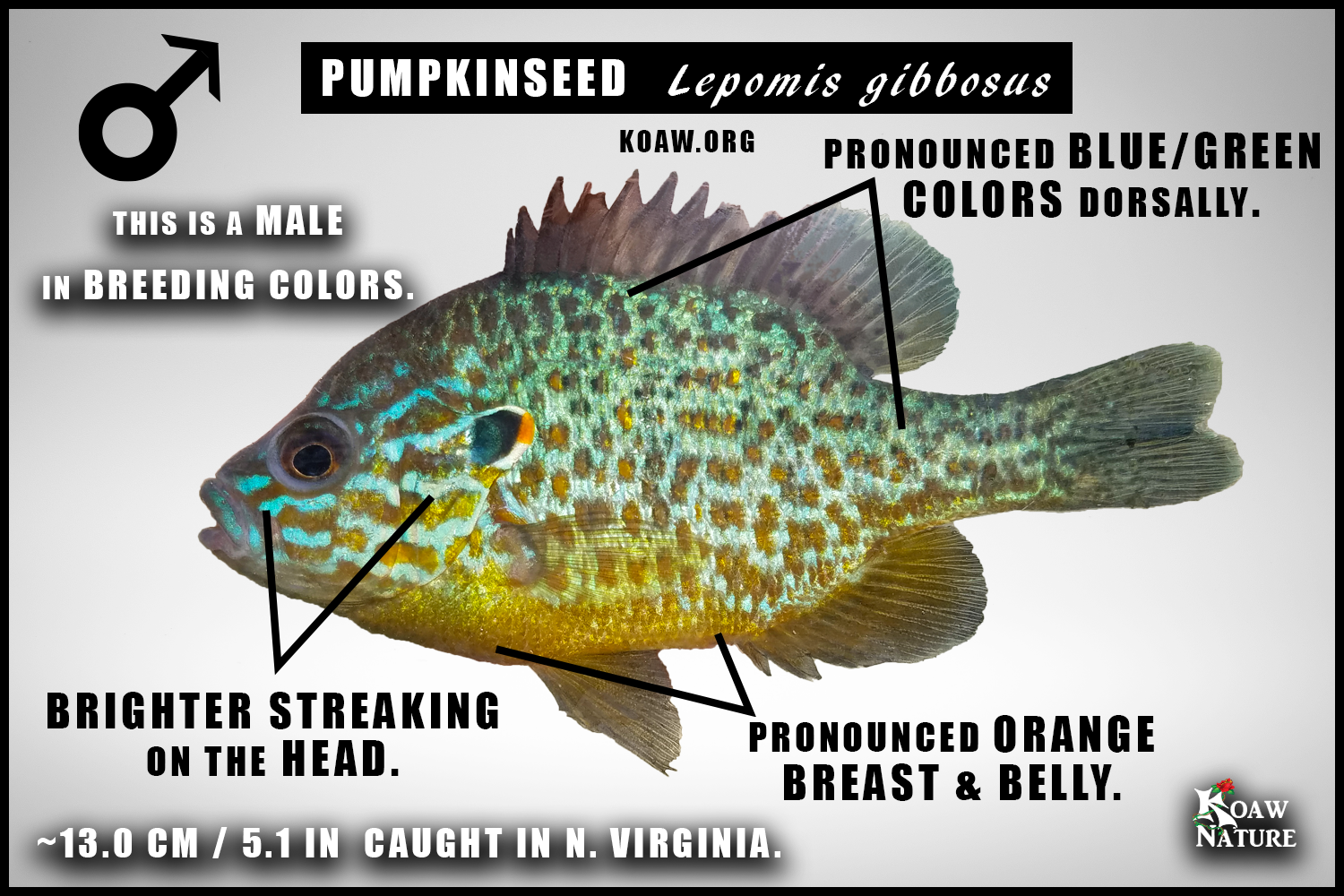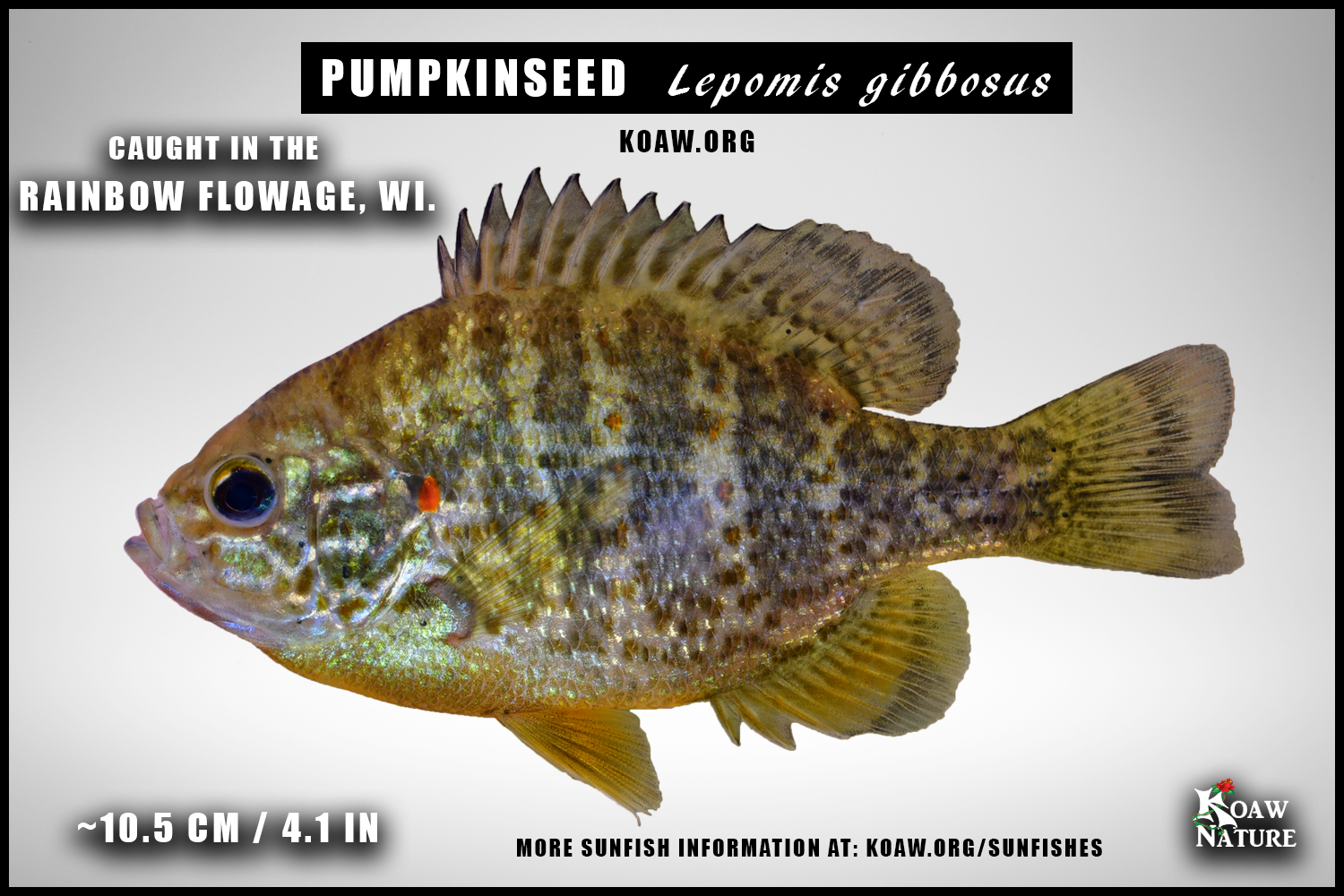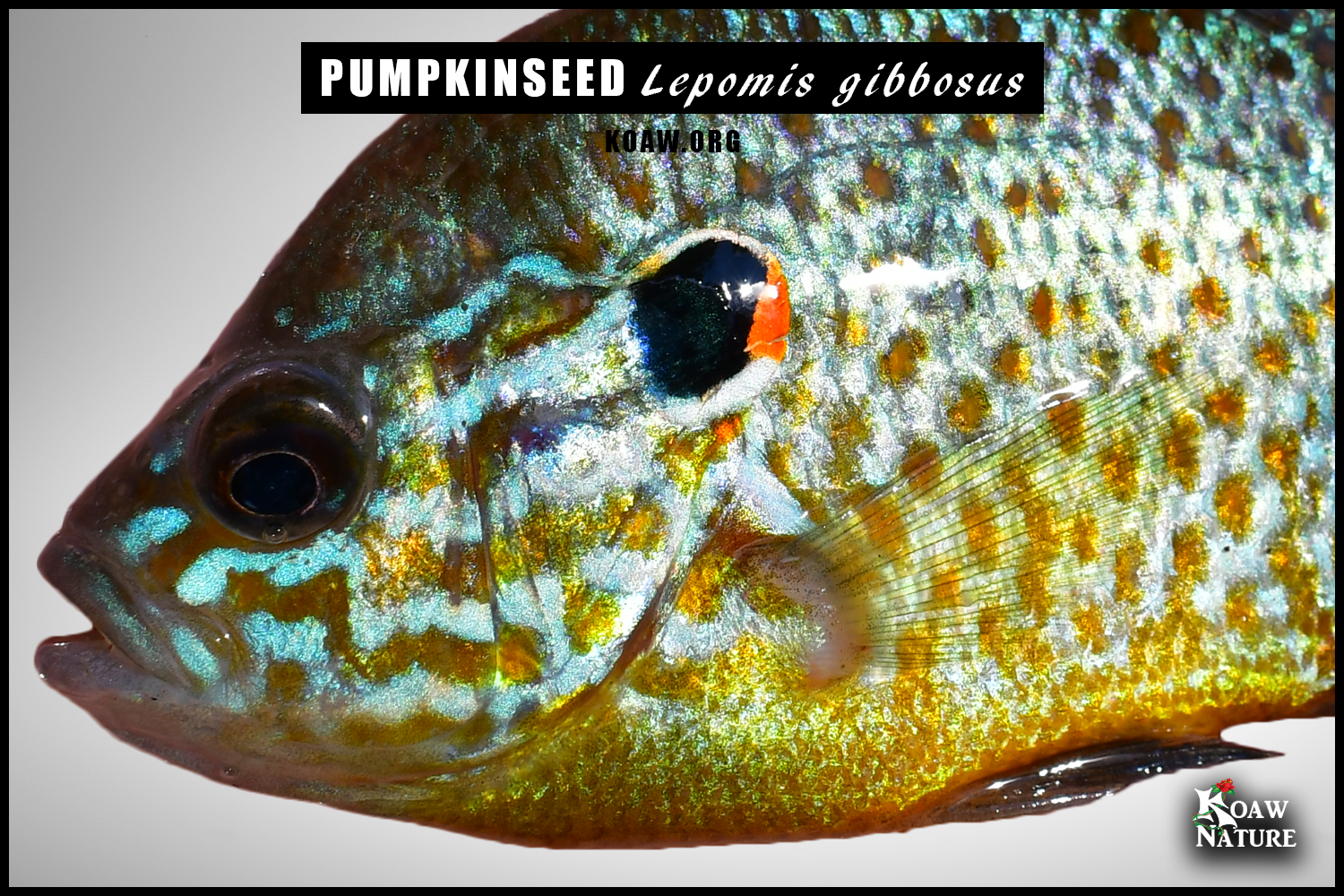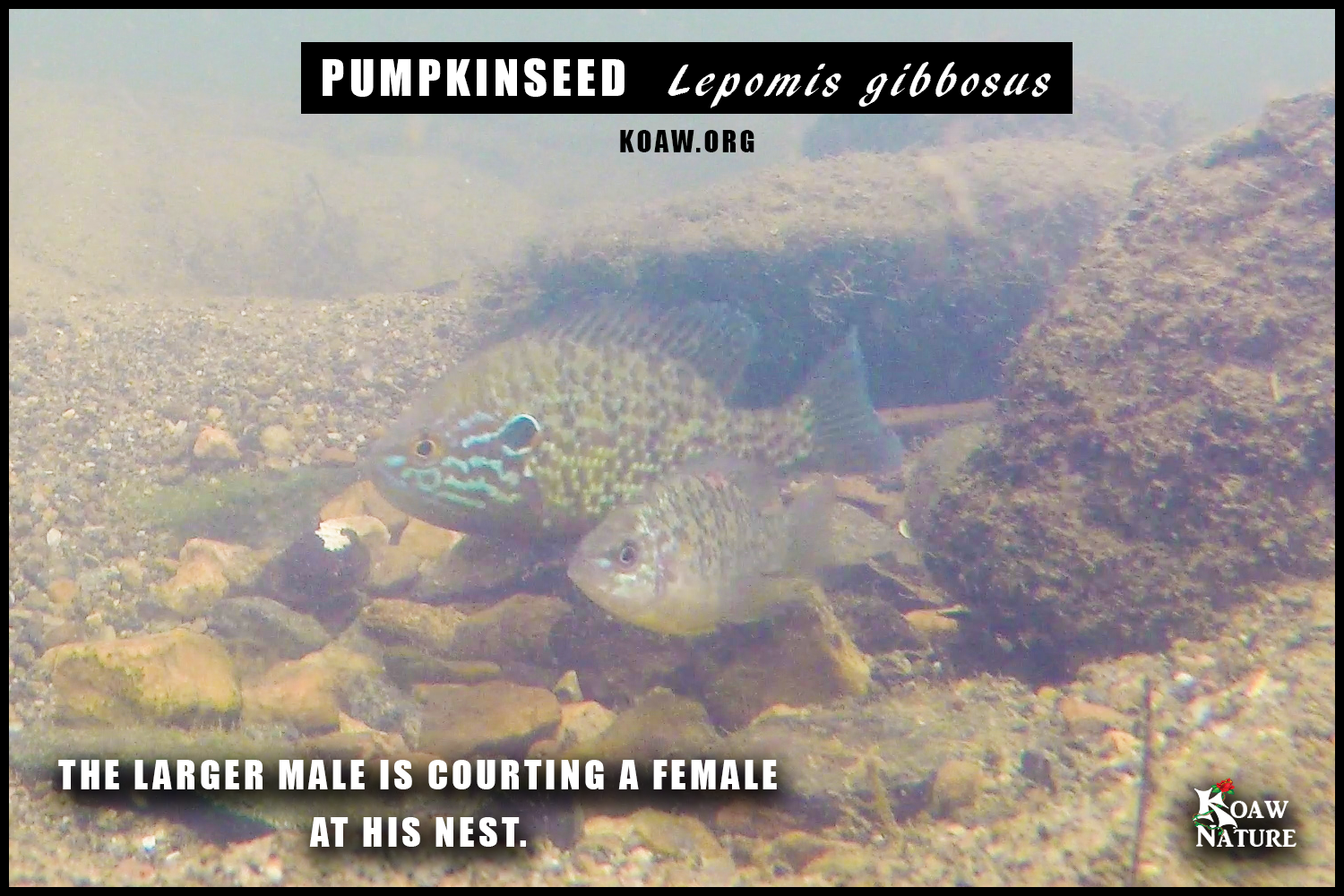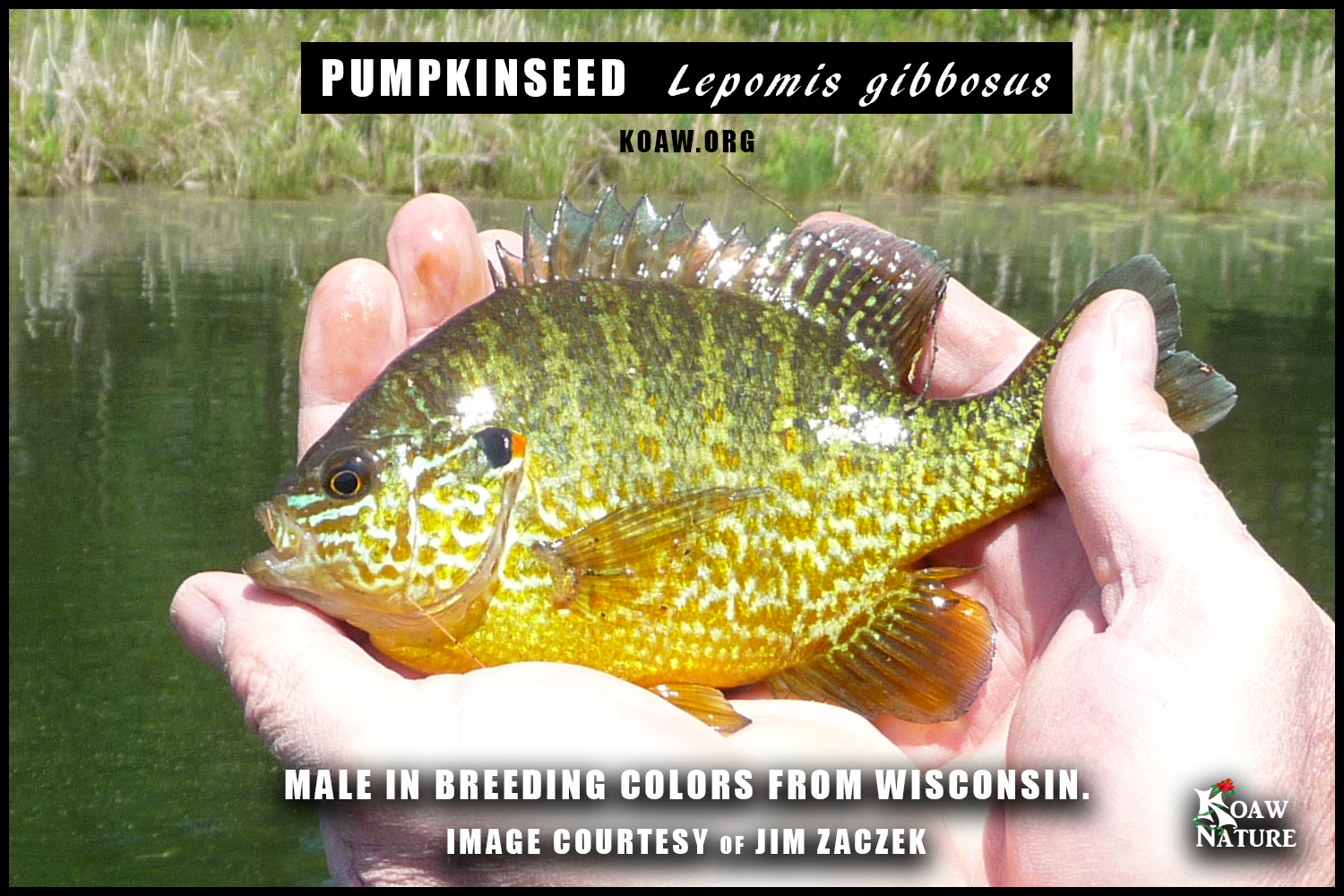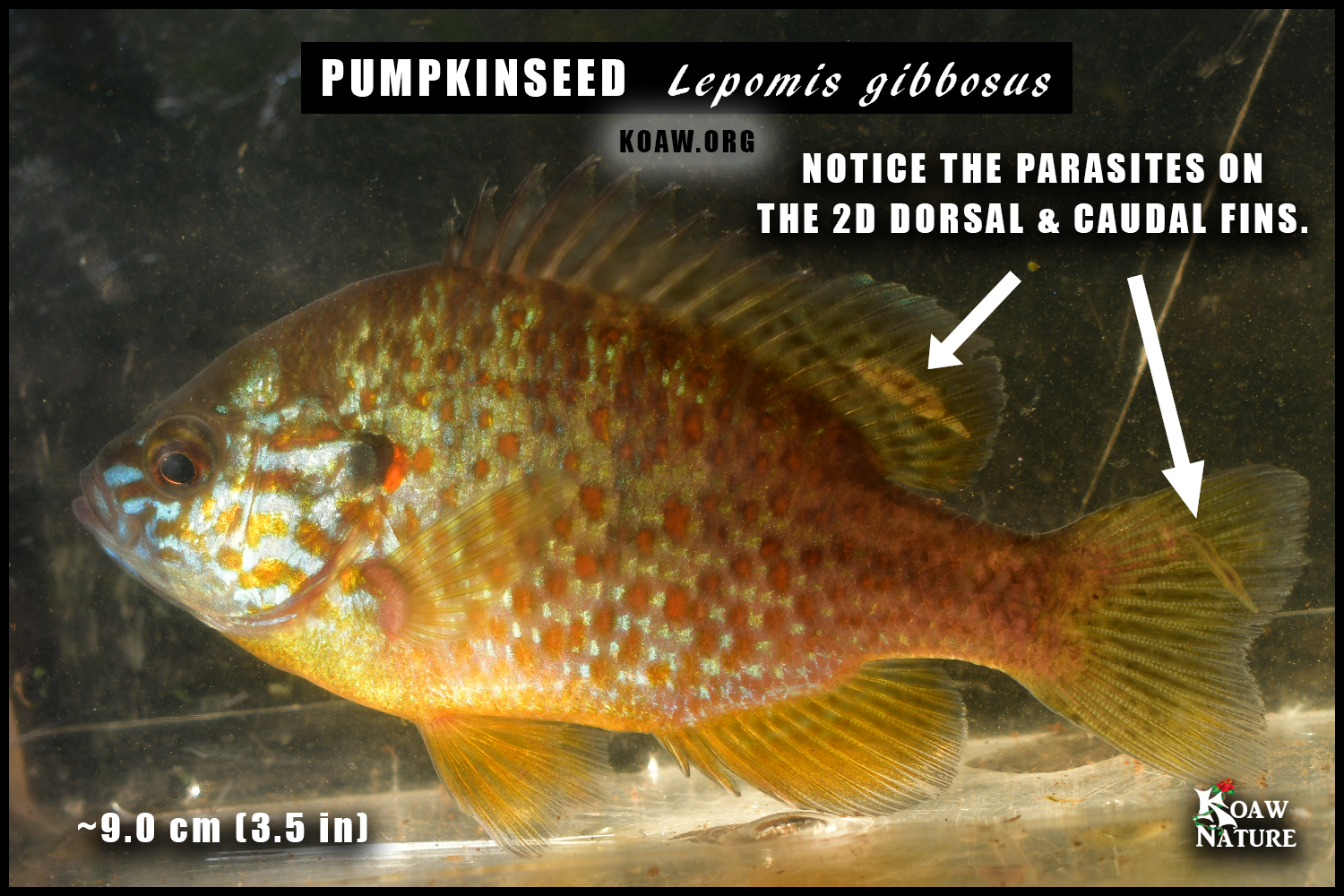By Koaw - November, 2020 (Updated Sept., 2021)
The video form of the pumpkinseed ID guide is here! Fishing tips also included.
GENERAL: The pumpkinseed (Lepomis gibbosus – Linnaeus, 1758) is one of the more colorful of the sunfishes with a native range primarily in the northeastern region of the United States and southern parts of Canada. This species has been widely introduced across North America and Europe; (See maps below under “LOCATION”.)
Good features to examine for an identification are the long pectoral fin, small mouth, spot pattern on the sides and the edging colors of the opercular flap.
The pumpkinseed has been found to hybridize with the following lepomids in nature: warmouth (L. gulosus), green sunfish (L. cyanellus), bluegill (L. macrochirus), orangespotted sunfish (L. humilis), northern sunfish (L. peltastes), redbreast sunfish (L. auritus), and longear sunfish (L. megalotis). [1] [2] [3] Theoretically, hybridizations with all other lepomid species is possible.
Click to enlarge the image. I caught these two at the same nesting spot.
The hybrid offspring of a pumpkinseed and green sunfish was previously considered as a unique species with the suggested name Lepomis euryorus. [4] Around 1920, Carl Hubbs suspected that Lepomis euryorus was not a pure species, rather the product of a hybridization event. [5] With his wife, Laura Hubbs, the two researchers were able to verify that Lepomis euryorus was actually the product of hybridization between green sunfish and pumpkinseed by allowing various lepomids to spawn in tanks. [6] Please see my “Introduction to Hybrids” page to learn more about identifying hybrid lepomids.
Meristics: Usually with 13 (12-14) pectoral rays, 3 anal spines, 10 anal rays, 10 (11) dorsal spines, and 11-12 dorsal rays. [7] [8]
BODY: The body, like with all lepomids, is compressed and deep like a disc. Typically the body depth is about 40-53% of the standard length. [9] The lateral line is complete with 35-47 lateral scales.[8] Certain environmental factors such as available diet and niche availability may alter the morphology of pumpkinseed, where some specimens may have much more elongated bodies compared to individuals in most populations.[10]
COLORATION: The pumpkinseed is one of the most vibrant and beautiful of the sunfishes, especially breeding males who take on brighter and more pronounced colors (though may be dulled in larger specimens.)
The body is generally olive above fading down to a greenish/blue sheen to an orange belly. Much yellow may exist on the body as well.
KEY FEATURE: The pumpkinseed will typically have brown to gold to orange spots scattered on much of the body. Some specimens will have many spots and some will have few. Typically pumpkinseed will have orange to gold spots on the upper body, a good feature to examine when comparing against the redear sunfish, a species that will typically only have gray to brown spots on the upper body. (Both pumpkinseed and redear may express gold-to-orange spots on the lower body and head.)
Usually at least five or six wavy light blue/teal lines radiate laterally across the head. These blue streaking patterns usually start on the snout before the eye and extend across the cheek and operculum. These streaks may be faded on some specimens, especially outside of breeding season.
The pumpkinseed usually has some bright blue iridescent coloring on the upper lip. This blue color, if present at all, may or may not extend across the entirety of the upper lip.
The median fins (the dorsal, caudal and anal fins) usually have dusky (sometimes orange-like) mottling patterns. Males will show more blue iridescence in the median fins than females; this blue iridescence is usually subtle, though on occasion a male specimen in breeding colors may almost appear to have longear-like amounts of blue iridescence in the median fins. Adult females and young have dark chainlike bars on the sides.[8][11]
SIZE: To 40 cm (16 in); [8] this maximum length suggested by Page & Burr is highly unlikely to encounter, especially in wild specimens. Most states report record pumpkinseed no larger than 30 cm (12 in). IGFA All-Tackle World Record 0.68 kg (1 lb 8 oz). [12]
A 20 cm (8 in) specimen is a nice-sized specimen. A 25 cm (10 in) specimen is worth getting a weight on as it may be a local record.
OPERCULAR FLAP: The “ear flap” will have a white edging both dorsally and ventrally that has a red/orange half-moon at the posterior edge.
The opercular flap is smaller on young specimens but remains short on adults. The red mark will usually be faintly visible on young specimens at least around 5 cm (2 in) which helps differentiate young pumpkinseed from young bluegill. [11]
Keep in mind that even on the same specimen the ear flap’s color edging may not be symmetrical from one side to the other. One side may appear as the adjacent image with a clean red spot while the other ear flap may have a more broken red spot. This occurs often even on the pure species specimens.
GILL RAKERS: The gill rakers on the 1st gill arch will be short and thick. These are easily seen by gently lifting the gill plate and examining the white portion above the red filaments on the gill arch closest to the gill plate.
I made a video describing how to locate and find these rakers that is hosted on Koaw Nature’s Fishing Smarts YouTube channel.
MOUTH SIZE: Like the bluegill, the pumpkinseed has a small mouth where the upper jaw does not extend underneath the pupil of the eye and often doesn’t even exceed the anterior margin of the eye.
More specifically, the maxilla’s most posterior edge will not exceed the anterior edge of the pupil (as the fish’s mouth is closed or nearly closed), often not even exceeding the anterior edge of the orbit.
PECTORAL FIN: Like the bluegill and redear sunfish, the pumpkinseed has a long, pointed pectoral fin that will usually bend well past the eye if bent forward. Typically the pumpkinseed has a shorter pectoral fin than the bluegill and especially the redear sunfish. In fast-moving water systems (like streams) the pectoral fin length may be reduced compared to populations inhabiting lentic (still water) systems. [13]
There are often 13 (12-14) pectoral rays. [7] [8]
Male pumpkinseed guarding his nest in a creek.
HABITAT: Pumpkinseed can be found in calm pools of creeks and small rivers as well as vegetated lakes and ponds. [8] [11] This species often requires gravel or sandy bottoms to spawn. [11]
Pumpkinseed will often be shoaling with other lepomids such as bluegill, redbreast sunfish and even green sunfish.
CLICK TO ENLARGE - This distribution map is an illustrated approximation created by Koaw primarily pulling data and information from USGS-NAS, Research Grade observations from iNaturalist and Page & Burr’s Field Guide to Freshwater Fishes.
LOCATION: The native range of the pumpkinseed includes the Atlantic drainages from New Brunswick down to the Savannah River in Georgia. The pumpkinseed is also native to the Great Lakes River Basin, Hudson Bay Basin (Red River in Manitoba) and upper Mississippi River Basin. [8] [14]
The pumpkinseed has been widely introduced across the northern parts of the United States and southern Canada. The southern parts of British Columbia, Ontario and Quebec have established populations of pumpkinseed. [14] [15]
Most countries in contiguous Western Europe now have established populations of pumpkinseed.[15] This species exists from Portugal in the southeastern parts of Europe up to the southern parts of Finland and expanding past Ukraine’s eastern border. The western coast of Turkey now has established populations of pumpkinseed.[16]
CLICK TO ENLARGE - This distribution map is an illustrated approximation created by Koaw primarily pulling data and information from iNaturalist. This map does not show all locations of invasive pumpkinseed populations in Europe.
Lepomis gibbosus populations exist in roughly 30 countries outside of the native range. The pumpkinseed will likely keep spreading well outside its range as climate change offers advantages to this early spawning lepomid.
FISHING: Pumpkinseed will hit a wide array of baits. On lakes, I have had success catching large pumpkinseed using live leeches on a floating jig head rig. I prefer using leeches to worms as sunfishes will often shred worms from a hook while leeches last longer and offer chances at larger specimens.
Weighted jig heads and soft plastics are amazing baits for pumpkinseed. (See Trout & Crappie Magnets on my gear suggestion page.)
In the pools of creeks, small flies of various sizes and types worked well. I caught the fish in the photo in a creek in N. Virginia using a spinning rod and a bead head fly.
In Wisconsin, I’ve noticed that in lakes prolific with bluegill populations, the mature pumpkinseed will more often be found in deeper water near tall macrophytes (aquatic plants) and structure like shelters, if not on or near the spawning beds in shallower water.
SIMILAR SPECIES:
REFERENCES:
W. F. Childlers, "Hybridization of Four Species of Sunfishes (Centrarchidae)," Bull. Ill. Nat. Hist. Surv., vol. 29, no. 3, 1967.
R. M. Bailey and K. F. Lagler, "An Analysis of Hybridization in a Population of Stunted Sunfishes in New York," Pap. Mich. Acad. Sci., Arts & Letters, vol. 23, 1937.
C. L. Hubbs, "A Check-List of the Fishes of the Great Lakes and Tributary Waters, with Nomenclatorial Notes and Analytical Keys," University of Michigan, Misc. Publications, vol. 15, 1926.
C. L. McKay, "A review of the genera and species of the family Centrarchidae, with descriptions of one new species.," Proceedings of the United States National Museum, vol. 4, no. 197, pp. 87-93, 1881.
C. L. Hubbs, "Notes on hybrid sunfishes.," Aquatic Life, vol. 5, pp. 101-103, 1920.
C. L. Hubbs and L. C. Hubbs, "Experimental Verification of Natural Hybridization Between Distinct Genera of Sunfishes," Papers of the Michigan Academy of Science, Arts and Letters, vol. 15, pp. 427-437, 1931.
Koaw, "Meristics and Morphometrics of Lepomids," 2020. [Online]. Available: https://www.koaw.org/lepomid-data.
L. M. Page and B. M. Burr, Peterson Field Guide to Freshwater Fishes, Houghton Mifflin Harcourt Publishing Company, 2011.
M. L. Warren, Jr., "Centrarchid Identification and Natural History," in Centrarchid Fishes: Diversity, Biology, and Conservation, S. J. Cooke and D. P. Philipp, Eds., Wiley-Blackwell, 2009, pp. 413-418.
C. J. Jastrebski and B. W. Robinson, "Natural selection and the evolution of replicated trophic polymorphisms in pumpkinseed sunfish (Lepomis gibbosus)," Evolutionary Ecology Research, vol. 6, pp. 285-305, 2004.
R. P. Jacobs and E. B. O'Donnell, "Sunfishes and Freshwater Basses," in Freshwater Fishes of Connecticut, Hartford, Connecticut Dept. of Environmental Protection, 2009, pp. 164-180.
IGFA, "Lepomis gibbosus Pumpkinseed World Record,"[Online]. Available: https://igfa.org/igfa-world-records-search/?search_type=ScientificName&search_term_1=Lepomis&search_term_2=gibbosus. [Accessed 2020].
J. Brinsmead and M. G. Fox, "Morphological variation between lake- and stream-dwelling rock bass and pumpkinseed populations," Journal of Fish Biology, vol. 61, no. 6, pp. 1619-1638, 2005.
USGS - NAS, "Lepomis gibbosus Nonindigenous Aquatic Species Map," [Online]. Available: https://nas.er.usgs.gov/queries/SpeciesAnimatedMap.aspx?SpeciesID=382. [Accessed August 2020].
iNaturalist, "Lepomis gibbosus Pumpkinseed," [Online]. Available: https://www.inaturalist.org/taxa/49614-Lepomis-gibbosus. [Accessed August 2020].
Gülnaz Özcan, "Distribution of the non-native fish species, pumpkinseed Lepomis gibbosus," Aquatic Invasions, vol. 2, no. 2, pp. 146-148, 2007.
